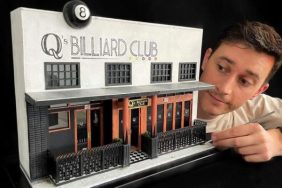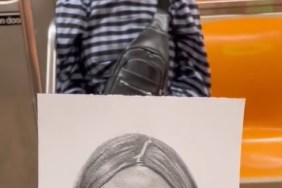Artwork: “Apology” Transparent coral colored film over black and white digital print. 32 x 32 inches.
Canadian artist Ben Skinner says all the things you don’t know how to say, and he does so in multiple mediums with wit, snark, and the occasional apologetic inflection.
Whether it’s “Let’s pretend tomorrow night never happened” in white UV ink on Alupanel laminated with dichroic film, “More than I hoped for but less than I expected” in acrylic on gold foiled leather, or “You were nice while I lasted” in enamel on wood panel, Skinner’s creations are curious, subtle studies on feelings of anticipation, disappointment, regret, and disillusionment.

Artwork: “I Think I Know” Acrylic on MDF framed behind privacy glass.
“I knew I wanted to be an artist ever since I was very young,” Skinner says. “I was encouraged by my parents and teachers who saw I was a stand-out creative kid with a talent for drawing. I knew I would pursue art making my whole life, whether it was a career or not.”
As a student in the MFA in art and technology program at the School of the Art Institute of Chicago, he was influenced by neo-conceptual artist Jenny Holzer, satirical sculptor Maurizio Cattelan, mundane object sculptor Tom Friedman, and contemporary artist Tom Sachs. It was in graduate school that Skinner began experimenting with words in his art; public text interventions in Chicago proved inexpensive, quick, ephemeral, and allowed viewers to interact with his art beyond gallery walls.
Skinner was eager to reach a larger audience in playful ways, an urge that lead him to a career creating window displays, first for Urban Outfitters in Boulder, Colo. and later in Edmunton, and now for Aritzia, a Vancouver-based women’s clothing company. As the longtime art director for visual displays, he designs seasonal window displays for more than 65 stores throughout North America, changing them out every six to eight weeks.

Window display: “The Collector” for Aritzia.
“In my opinion, a display will draw attention when it’s treated like an art installation as opposed to a marketing campaign designed around merchandising and large photos of models,” Skinner says. “To see something that is more like abstract sculpture made from quality materials is a pleasant break from the norm in a retail display.”
One of the perks of his day job is access to the company’s studio, materials, and tools. Skinner employs dozens of materials in his artwork, many likely foreign to laymen: holographic transfer foil, acrylic mirror, reed glass. Others are more familiar: Plexiglas, silk chiffon, Styrofoam, faux eyelashes, neon, stainless steel. At times, the medium inspires the idea; other times, it’s the reverse. “Over the years I’ve become more and more interested in materials and techniques, and enjoy learning and exploring in that way,” he says. “I’m most drawn to clean aesthetics that relate to design and removing the evidence of the artist’s hand.”
Skinner’s personal and professional creations differ in scale and budget. Designing displays also involves more logistical hurdles and creative limits, as well as the problem-solving and decision-making skills. But both methods of making art feed one another. “That fact that I need to continually come up with fresh and exciting ideas for my day job is a discipline that has spurred on an eclectic-ness to my own practice,” he says.

Artwork: “Same Same” Acrylic tinted HydroCal plaster.
Skinner’s personal artwork is where text really gets to play. He often produces a short series of projects that are seemingly unrelated to the group of work that came before, tinkering with particular techniques or materials—infinity mirrors, gold-leaf glass gliding, and paper or silk marbling, for example—intermittently for a few years. “I like to push the materials to do things that seem new and interesting to me; things I haven’t seen before,” he says.
Most of the phrases in his work are original, though he has also pulled from misquotes of common phrases, lyrics, and overheard or misheard conversations. He keeps lists of potential material in notebooks and in a phone app; occasionally, the language comes first, and he experiments with what material will broadcast the message best.
No matter what the medium, Skinner—who plays speed chess and juggles in his spare time—hopes to evoke curiosity, thoughtfulness, a smile, or a laugh in the viewers of his art. “But I’m also happy if people just think it looks cool,” he says.






